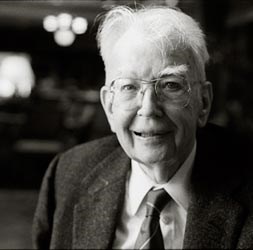I'm a student in Professor Arvan's Econ 490 Class, using renowned economist Ronald Coase as my alias.
Friday, September 5, 2014
Ronald Coase's Biography
Ronald Coase was born on December 29, 1910 in England. He was a Law professor at the University of Chicago for many years and also published many notable papers which include: "The Problem of Social Cost", "Nature of the Firm", and "The Lighthouse in Economics". Coase wrote one of his most famous papers, "Nature of the Firm" in 1937 at only 26 years of age. This paper discusses why people chose to organize themselves in business firms rather than having each one independently contracting for themselves. He is said to have introduced the concept of transaction costs and use that term throughout all his papers. Transaction costs are the costs each party incurs in the course of buying and selling things.
One of his other more famous papers is called "The Problem of Social Cost". This paper discusses his belief that government intervention is the only way to restrain people and companies in ways which are harmful to others. The paper also divulges into property rights using the famous example of the farmer and the rancher. Ronald Coase is also famous for the Coase Theorem which states that when conflicting property rights occur, bargaining between parties involved will lead to an efficient outcome regardless of which party is ultimately awarded property rights, as long as transaction costs are negligible.
Ronald Coase was awarded the Nobel Prize in Economics in 1991 for "his discovery and clarification of the significance of transaction costs and property rights for the institutional structure and functioning of the economy." Ronald Coase was an inspiration to many and his views changed the way we look at economics today. Ronald Coase passed away about a year ago on September 3rd, 2013 at the age of 102.
Subscribe to:
Post Comments (Atom)

Transactions costs are Coase's baby. We will be talking about them tomorrow in class. It is good to associate the name of the person who first came up with the idea to the idea itself. It makes the idea more familiar that way.
ReplyDelete